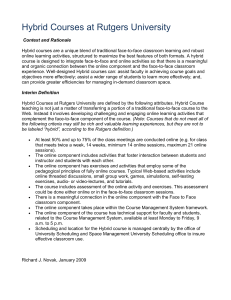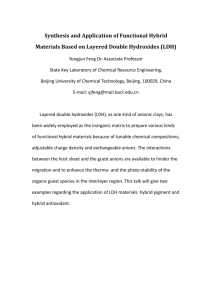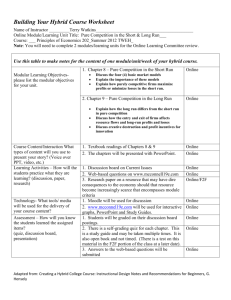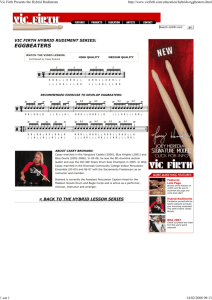A Youth Group's Experience with a Hybrid Approach to “How People
advertisement
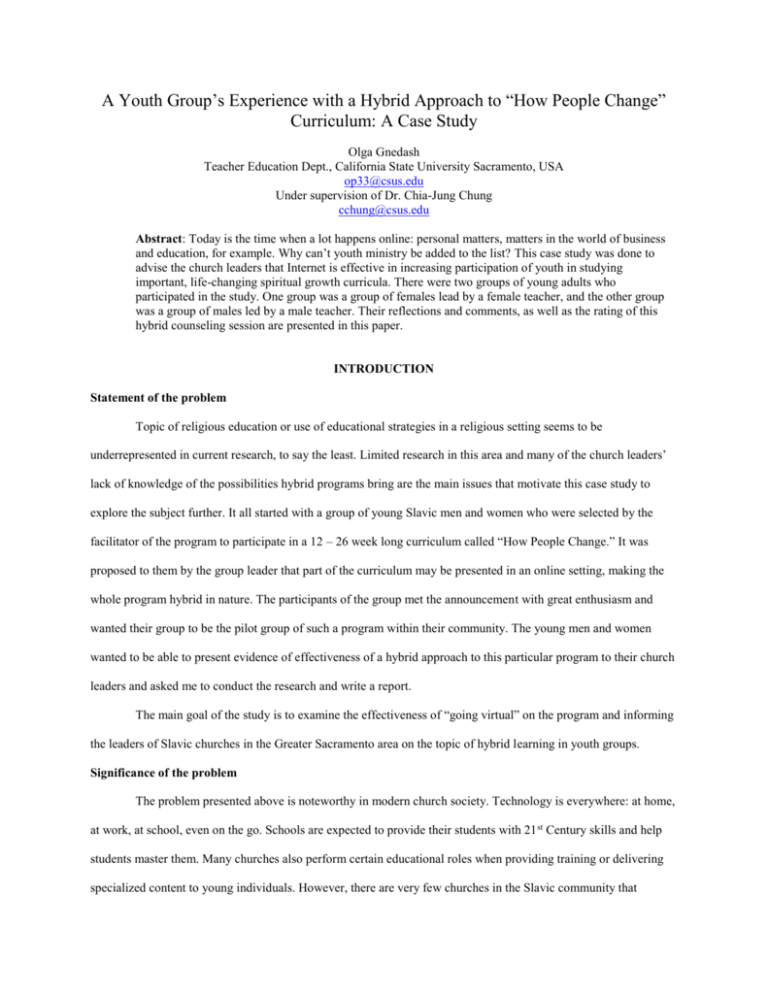
A Youth Group’s Experience with a Hybrid Approach to “How People Change” Curriculum: A Case Study Olga Gnedash Teacher Education Dept., California State University Sacramento, USA op33@csus.edu Under supervision of Dr. Chia-Jung Chung cchung@csus.edu Abstract: Today is the time when a lot happens online: personal matters, matters in the world of business and education, for example. Why can’t youth ministry be added to the list? This case study was done to advise the church leaders that Internet is effective in increasing participation of youth in studying important, life-changing spiritual growth curricula. There were two groups of young adults who participated in the study. One group was a group of females lead by a female teacher, and the other group was a group of males led by a male teacher. Their reflections and comments, as well as the rating of this hybrid counseling session are presented in this paper. INTRODUCTION Statement of the problem Topic of religious education or use of educational strategies in a religious setting seems to be underrepresented in current research, to say the least. Limited research in this area and many of the church leaders’ lack of knowledge of the possibilities hybrid programs bring are the main issues that motivate this case study to explore the subject further. It all started with a group of young Slavic men and women who were selected by the facilitator of the program to participate in a 12 – 26 week long curriculum called “How People Change.” It was proposed to them by the group leader that part of the curriculum may be presented in an online setting, making the whole program hybrid in nature. The participants of the group met the announcement with great enthusiasm and wanted their group to be the pilot group of such a program within their community. The young men and women wanted to be able to present evidence of effectiveness of a hybrid approach to this particular program to their church leaders and asked me to conduct the research and write a report. The main goal of the study is to examine the effectiveness of “going virtual” on the program and informing the leaders of Slavic churches in the Greater Sacramento area on the topic of hybrid learning in youth groups. Significance of the problem The problem presented above is noteworthy in modern church society. Technology is everywhere: at home, at work, at school, even on the go. Schools are expected to provide their students with 21 st Century skills and help students master them. Many churches also perform certain educational roles when providing training or delivering specialized content to young individuals. However, there are very few churches in the Slavic community that incorporate 21st century skills into their curricula, creating a misbalance and a gap between what their youth experiences on a daily basis and what the church offers. This study will not be performed in a traditional educational setting; however, is very education-based in nature. The curriculum used by the leaders of the two small study groups (one group is the young women and the second one is the young men) is not the traditional “learn and take a summative assessment” type of curriculum. The curriculum is written by Timothy S. Lane, M. Div., D. Min., and Paul David Tripp, M. Div., D. Min., who are counselors and faculty members at the Christian Counseling & Educational Foundation in Glenside, Pennsylvania, and lecturers in practical theology at Westminster Theological Seminary. This study will not evaluate the curriculum, nor will it attempt to somehow measure the mastery of the material; rather, it will examine the effect of the technology component that is brought into the program by enthused interest of the participants. The report of the findings will be presented to the church leaders with a purpose of advocating for hybrid models of youth group curricula. Since the participants are mostly young adults who are familiar with online and hybrid learning models, the logistics of the online component will not be difficult to master. Research questions The major research questions this study attempts to answer are the following: (1) How does the added online component increase participation, communication, and motivation within each small group? (2) Does the online component improve or hinder the sense of community within the small group? (3) What is the difference, if any, between the males’ and females’ satisfaction level with a hybrid approach to youth groups? Definitions 21st century skills – the skills an average student needs to acquire in order to be successful in modern society; that is be able to learn to think and work in a way that is creative and, most of the time, collaborative. The skills may include but are not limited to: finding and managing resources, collaboration and communication, critical thinking, problem-solving, posting on the Web, etc. “How People Change” curriculum – curriculum designed for small church groups, whose members are committed to rigorously work together with a common goal of changing into a “better person”. Sense of community – is a sense of belonging and/or acceptance in a group setting. This may include feeling safe to share personal information/feelings, to speak up, not be judged, feeling a part of the group where everyone is expected to contribute; interconnectedness. Hybrid approach – in addition to the face-to-face meetings, participants will be asked to participate in a virtual learning environment via Schoology.com. Schoology.com – a learning management system (LMS) and social network with an interface that is similar to that of Facebook. Schoology makes it easy to create and share academic content. It was the first site that created a secure social network for education. Accountability partner – (a variation of “buddy system”) a term used in place of the word “buddy”. Accountability partners are to meet at least once a week, in addition to the whole group meetings, to discuss each other’s progress. Accountability partners are encouraged to share strategies/struggles, work on assignments together, remind of upcoming homework, and encourage each other to diligently study the material. Attendance is defined as both face to face and virtual attendance of any group discussions/exercises. Description of the Innovation/Intervention The group has been working together since September 2012, establishing norms, roles, a sense of community, and a safe environment for participation and openness of the members. The innovation is introducing a virtual learning environment (VLE) in Schoology.com to allow for asynchronous online discussions, more opportunities for communication among the participants, and extra accountability partner interactions. The online component will be introduced roughly half-way in the course of the program. METHODOLOGY Data In the course of my research, I will be collecting both quantitative and qualitative data. I want to approach a triangulation mixed-methods action research, also known as convergent parallel design, because I believe it to be most effective when drawing conclusions. This means that I will need to collect both quantitative and qualitative data simultaneously, compare and relate it, and interpret. Quantitative For quantitative data collection I will obtain data about attendance/participation from group leaders (in forms of attendance sheets and participation grades on a three-point scale with one being little or no participation, 2 being moderate participation, and 3 being active participation). In addition, some demographic information can be used as quantitative data (percent male vs. percent female find the opportunity to do homework online very useful, etc.). Also, I plan to incorporate Likert scale into my surveys (to rate satisfaction with the program’s online component and other areas of the program) which can then be treated as numerical data of averages of the responses (See Appendix E and Appendix F). Qualitative To collect qualitative data on participants’ use and general feeling about the online component, I will ask open-ended questions in my questionnaires and conduct interviews. Assumptions The main assumption in this study is that the participants will actively engage in discussion and reflection online, as well as during face-to-face meetings. I am assuming that the group members will like Facebook-like virtual classroom environment and would view it as an additional resource. Not only this Web site offer peer interactions, it also stores all of the discussions, reflections, and personal messages, with an added level of security, and even, if desired, anonymity. I assume that many will find such a format more useful or convenient than keeping a journal and having to make time for the face-to-face accountability partner meetings. One other assumption I have is that the convenience of an online environment will enhance participation both online and during the face-to-face meetings, as well as increased amount of communication among the members. In addition, I think that there may be an increase of motivation to do the course homework, since it will be available online. Limitations The major limitation of this action research is that it is specific to only these ten individuals and this particular curriculum of Bible study. The results might not be generalized to other small youth groups, studying at a different pace/different format of material. In addition, my research will be limited because I was not able to get a control group for this study. I believe that a control group would strengthen this project (and add participants, which is also a plus). Availability of technology is a potential limiting factor. However, due to the fact that most participants are contemporary youths, most of them (if not all) have access to the Internet either in the privacy of their home or even on their mobile device (which is very convenient because Schoology launched a mobile application not long ago). Delimitations One of the delimitations is the small sample size. Sample sizes less than 100 generally do not reflect the trend of the population and thus the findings cannot be generalized to larger population (even to the population of a particular church youth group). Also, it certainly cannot be generalized to the city level due to the uniqueness of this groups’ population – mainly Eastern European, Slavic-American young men and women. REFERENCES Conn, S. R., Roberts, R. L., & Powell, B. M. (2009). Attitudes and Satisfaction with a Hybrid Model of Counseling Supervision. Educational Technology & Society, 12 (2), 298–306. de la Varre, C., Keanie, J., and Irvin, M. J. (2010). Enhancing online distance education in rural U.S. schools: a hybrid, learner-centered model. ALT-J, Research in Learning Technology, 18(3), 193-205. Doering, A. and Veletsianos, G. (2008). Hybrid online education: Identifying integration models using adventure learning. Journal of Research on Technology in Education, 41(1), 23-41. Kenney, J. and Newcombe, E. (2011). Adopting a blended learning approach: Challenges encountered and lessons learned in an action research study. Journal of Asynchronous Learning Networks, 15(1), 45-57. Light, D. and Polin D. (2010). Integrating Web 2.0 tools into the classroom: Changing the culture of learning. EDC Center for Children and Technology. Morevec, M., Willilams, A., Aguilar-Roca, N., and O'Dowd, D. (2010). Learn before lecture: A strategy that improves learning outcomes in a large introductory biology class. CBE - Life Science Education, 9, 473481. Wachira, P., and Keengwe, J. (2011). Technology integration barriers: Urban school mathematics. Teacher perspectives.J SciEducTechnol, 20, 17-25.

